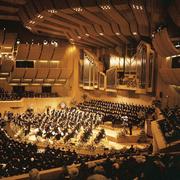Berliner Philharmoniker
by Corie Stanton RootIn a city of rich cultural and artistic history, the Berlin Philharmonic Orchestra is the most outstanding of Berlin's three excellent orchestras. A democratic, self-governing organization, members choose the resident conductor, orchestra manager and new orchestra members (after a one-year probation) by vote of the membership at large. Members with ten years' seniority are eligible for pension benefits. Performing approximately 100 concerts a year, the Berlin Philharmonic tours internationally and generates most of its operating capital through ticket sales and revenue from its extensive broadcasting and recording contracts. Several significant ensembles including the Brandis and Westphalian string quartets, the Philharmonic Octet and the Twelve Philharmonic Cellists are made up from the Berlin Philharmonic's one hundred fourteen members. Internationally acclaimed for its polished performances and the high standard of musicianship among its members, the Berlin Philharmonic is one of Europe's most distinguished ensembles.Founded in 1862 by Benjamin Bilse under the name Bilsesche Kapelle (Bilse's Band), the original sixty-member ensemble gained popularity and played more than 3000 concerts during the next twenty years. Renamed and reorganized under the financial management of Hermann Wolff in 1882, the Berlin Philharmonic Orchestra chose Ludwig von Brenner as principal conductor. Although von Brenner made significant improvements in the group's musicianship, it was Hans von Bülow who set the ensemble on its course of artistic excellence. Beginning his five-year tenure as principal conductor in 1887, von Bülow concentrated on classical and romantic repertoire and insisted on the highest musical standards. He also attracted world-renown guest conductors such as Tchaikovsky, Brahms and Strauss and supervised the renovation of the orchestra's home venue; a converted roller skating rink. Due to ill health, von Bülow resigned his position in 1892. The Philharmonic played at his funeral ceremony in February 1894.Over the next several years, Wolff engaged a series of popular guest conductors including Hans Richter and Richard Strauss. Then in 1895, Hungarian-born Arthur Nikisch was chosen as resident conductor and led the Berlin Philharmonic to its well-earned reputation as the most respected touring orchestra in Europe. His choice of romantic repertoire and his expressiveness on the podium brought out the lyrical qualities for which this ensemble became famous.Soon after Nikisch's death in 1922, the reins of leadership were given to Berliner Wilhelm Furtwängler who continued in Nikisch's musically romantic footsteps even in the face of the difficult times brought about World War I, the Weimar Republic and the rift between the romantic and avant-garde schools of composition. He devoted a large portion of the orchestra's concerts to the works of Beethoven, Brahms, Schubert and Richard Strauss with his interpretation of Beethoven's Eroica receiving special acclaim. Over the next two decades, Furtwängler debuted works by the likes of Debussy, Stravinsky, Prokofiev and Schoenberg. The orchestra toured extensively during his reign and welcomed world-famous guest conductors such as Bruno Walter, Oskar Fried and Otto Klemperer. Important soloists were also a regular feature during this period and included such luminaries as Paul Hindemith and Yehudi Menuhin who made his professional debut with the Philharmonic at the age of twelve.Difficult economic times came after the world-wide financial crash in 1929 but the ensemble was able to survive through subsides from the city of Berlin, the German government and the Berlin Radio Network. More problems came with Hitler's rise to power. Furtwängler's public support of Hindemith brought him in direct conflict with Georges Goebbels, Propaganda Minister for the new regime. As a result, Furtwängler resigned his post as principal conductor but returned to the podium in March 1935, taking a stand for artistic excellence over political rancor. Further hardship was visited on the Philharmonic when its home venue was destroyed by a bomb in January, 1944. Performing in borrowed spaces, the orchestra continued even after the beloved Furtwängler was detained during the political vindication proceedings which took place after Hitler's fall in 1945. Leo Borchard was named resident conductor in May 1945 but was shot and killed by an Occupation soldier three months later. Sergiu Celibidache was chosen to follow Borchard and was widely acclaimed for his inclusion of contemporary repertoire, much of which had been banned during Hitler's reign. When Furtwängler was finally released in 1947, he and Celibidache shared the Berlin Philharmonic's podium until Furtwängler's death in 1954.Despite Celibidache's considerable abilities as a conductor, the members of the Philharmonic chose Herbert von Karajan as resident conductor in 1955. This was due, in large part, to von Karajan's well established reputation as the conductor of the Symphony Orchestras in London and Vienna and to his openness to the recording industry. Celibidache had refused all recording offers during his tenure and this did not sit well with many of the orchestra's members. The musical foundation of von Karajan's long and illustrious association with the Berlin Philharmonic was based on the major Classical and Romantic symphonies but was liberally peppered with significant twentieth-century works. Under his leadership, the orchestra toured and recorded extensively which brought the ensemble world-wide recognition. At home, the Philharmonic began construction of a new concert hall in1963. Designed by architect Hans Scharoun, the orchestra's home venue near Berlin's Brandenburg Gate seats two thousand audience members and contains an impressive Schuke organ. Von Karajan also began the orchestra's tradition of committing five performances each season to twentieth-century music which has given the Berlin Philharmonic the honor of premiering dozens of important contemporary works.Herbert von Karajan died in 1989, ending his nearly thirty-five year tenure as the Philharmonic's beloved resident conductor. Late in that same year, Claudio Abbado was chosen to continue the Berlin Philharmonic's tradition of musical excellence and polished performance and lead this world-renown orchestra into the twenty-first century.


 La Marseillaise (马赛进行曲) - Berliner Philharmoniker
La Marseillaise (马赛进行曲) - Berliner Philharmoniker




























![[STATION] aespa《Dreams Come True》MV Teaser - aespa (에스파)](https://img2.kuwo.cn/wmvpic/324/79/54/2120387380.jpg?imageView2/1/w/195/h/130/format/jpg/q/60)





